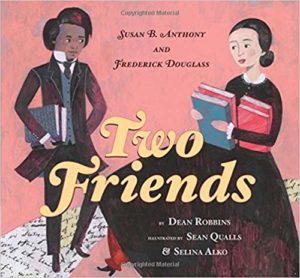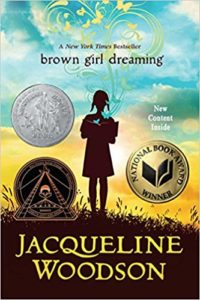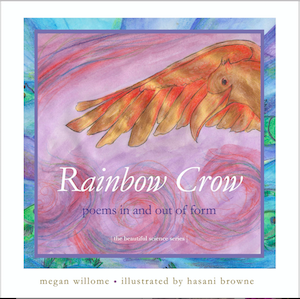When looking for materials to use in the Tea Time workshop, I discovered Two Friends through random Googling. The story by Dean Robbins and illustrated by Sean Qualls and Selina Alko is about Susan B. Anthony and Frederick Douglass. They were not only reformers but also friends who had tea together. In 2001, a statue called Let’s Have Tea was installed in Susan B. Anthony Square Park in Rochester, New York. This year the city is celebrating the bicentennial of Frederick Douglass’s birth.
This book is a twist on the picture book biography, a staple in children’s lit. It’s a way to teach history in bite-sized pieces, often taking a small detail and building a story around it. Like many picture book biographies, it includes biographical sources, including historical photos and a bibliography, which includes Douglass’s Narrative of the Life of Frederick Douglass, an American Slave, published in 1845. This book may be for kids, but its source material is the real deal.
Two Friends came out in 2016, so as you read, imagine you’re an elementary-aged child who is learning this slice of American history for the first time. You’re reading the words, but you’re also paying a lot of attention to the pictures.
Picture book biographies serve young readers by using the illustrations as a way to show, not tell, the research that went into the story. Within the illustrations are the actual words of Anthony and Douglass. They’re worked into the moon, into bloomers. They come out of Douglass’s and Anthony’s mouths as they give speeches, as if they’re on paper. The reformers actually stand on their own words. Words rise from their teacups: “Right is of no gender, is of no color. Truth is of no color,” and “We are all brethren.”
The text distills this period of American history into simple sentences for young readers. Both reformers are motivated by the same thing — “The right to live free. The right to vote.” — so that sentence is repeated for Anthony and Douglass. Anthony’s motivation is expressed this way: “Some people had rights, while others had none. Why shouldn’t she have them, too?” Douglass’s motivation is identical, except for one word: “Some people had rights, while others had none. Why shouldn’t he have them, too?
“Outrageous!”
That’s what a man in a top hat with a moustache shouts at Anthony while she gives a speech. The book summarizes his complaint as, “Some people liked her ideas about rights for women. Others didn’t.” Similarly, when Douglass is giving a speech, a man in a different-colored top hat with a different-colored moustache appears to be seething. Again, his outrage is expressed as a simple refrain: “Some people liked his ideas about rights for African Americans. Others didn’t.”
Too often we think about history in chunks. It’s February, African-American History Month, so we’ll talk about Frederick Douglass. Susan B. Anthony will have to wait until the November 2020, when we recall that she was arrested for attempting to vote in the 1872 presidential election. This book forced me to consider not only the overlap between the civil rights and women’s rights movements, but also how each inspired the other.
The author and illustrators have both worked on other historical books for children. Author Dean Robbins has written two other picture book biographies and has two more coming out — one in 2019 and one in 2020. He was a journalist before he turned to writing for children. When he went to Rochester to do research for this book and learned Anthony and Douglass met for tea, he described his reaction to that fact this way in an interview with International Literacy Association: “I’d felt similarly elated as a kid when I read comic books in which Batman and Superman teamed up as an invincible pair. It seemed too good to be true.”
Illustrators Alko and Qualls are a wife-and-husband team. Their first collaboration was in 2015 on The Case for Loving: The Fight for Interracial Marriage. Here’s a video featuring Qualls and his artistic process.
The key to Two Friends is the collaboration between Anthony and Douglass, expressed in these eight words: “Susan liked Frederick’s ideas, and he liked hers.” That’s why the two friends had tea, to learn more about each other’s ideas and the people behind them.
Tea is the beginning and ending of the book, providing bookends to the history lesson. Two friends, two candles, “two saucers, two cups, and two slices of cake.” The tea provides a cozy feeling, with snow outside, a crackling fire inside, and friends sipping from blue and white china cups, despite the upheaval in the middle of the story, as each reformer attempts to change the world: Anthony, with speeches; Douglass, with his newspaper.
It’s no secret I’m a tea-lover. I believe more conversations held while sipping this beverage would put more good in the world. But the story is not only about two reformers strategizing to change the world. It’s also about friendship.
“They would get right to work. As soon as they finished their tea.”
_______________
The next Children’s Book Club will meet Friday, September 14. We’ll read Brown Girl Dreaming by Jacqueline Woodson. It’s not a picture book — it’s a memoir told through poems. I’ll be discussing it more next Friday in a two-part series about Laura Ingalls Wilder’s legacy.
Photo by Ryan Blyth, Creative Commons, via Flickr. Post by Megan Willome, author of The Joy of Poetry.
Browse more Children’s Book Club
“Megan Willome has captured the essence of crow in this delightful children’s collection. Not only do the poems introduce the reader to the unusual habits and nature of this bird, but also different forms of poetry as well.”
—Michelle Ortega, poet and children’s speech pathologist
- Perspective: The Two, The Only: Calvin and Hobbes - December 16, 2022
- Children’s Book Club: A Very Haunted Christmas - December 9, 2022
- By Heart: ‘The night is darkening round me’ by Emily Brontë - December 2, 2022




L.L. Barkat says
Agreed, this is a great way to get your history quotient. 🙂
And I’d heard, somewhere, the idea about how the two movements were helpful to one another. It shows the value of teaming up across interests and “industries”—rather than only pursuing a single path towards change or discovery.
Megan Willome says
Yes, the book made me wonder how the two movements influenced each other in ways no one will ever know.
L.L. Barkat says
I seem to additionally remember something about how the Vote movement also eventually paired with the group responsible for the Temperance movement (this was vigorously disputed within the Vote movement and, according to one source I read, put the movement back by about 20 years—it’s a strong lesson in how people who think they have differences (and, of course, they do) can still find points of powerful intersection to bring about deep and important social change together).
Megan Willome says
So, we don’t need to agree on everything in order to have consensus. Sounds like a great picture book topic!